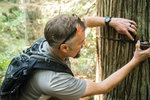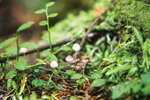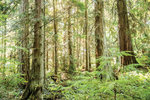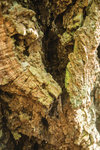In the midst of all the noise of modern day living—car engines, Navy jets, ferry fog horns—it seems impossible to find some quiet.
For author Steve Grace, it was in seeking a few quiet moments in the woods that he made an amazing discovery: in the middle of the Quimper Peninsula sat a secret, ancient and quiet world.
This item is available in full to subscribers.
We have recently launched a new and improved website. To continue reading, you will need to either log into your subscriber account, or purchase a new subscription.
If you had an active account on our previous website, then you have an account here. Simply reset your password to regain access to your account.
If you did not have an account on our previous website, but are a current print subscriber, click here to set up your website account.
Otherwise, click here to view your options for subscribing.
* Having trouble? Call our circulation department at 360-385-2900, or email our support.
Please log in to continue |
|




In the midst of all the noise of modern day living—car engines, Navy jets, ferry fog horns—it seems impossible to find some quiet.
For author Steve Grace, it was in seeking a few quiet moments in the woods that he made an amazing discovery: in the middle of the Quimper Peninsula sat a secret, ancient and quiet world.
“I was mainly looking for a shortcut to avoid running on the road,” Grace said. He moved to Port Townsend nearly two years ago. A trail runner and a lover of marine biology, Grace wanted to find a path through his neighborhood forest to run down to Cape George, where he was participating in citizen science research in the intertidal zone.
As he started bushwacking his way through the forest located between Kruse Street and Cape George Road to create a running trail, he began to appreciate his shortcut for more than just its convenience.
Surrounded by layers of bark and moss, this forest wasn’t completely void of sound. Birds sang, squirrels scurried along tree limbs, wind rustled pine needles as swaying trees creaked.
“I had this private paradise to myself,” he said, describing the long meandering walks he would take, sometimes getting lost for hours in what felt like a wilderness.
But soon Grace realized that this paradise could swiftly be transformed into a stump ranch.
The 30 acres of land where Grace found an ancient forest is owned by Washington’s Department of Natural Resources, established to manage state timberlands to benefit public schools and other entities. When he contacted Brian Turner, who is the Straits District Manager for the Olympic Region of DNR, Grace found out the area was to be harvested within the next 1 to 5 years.
“The area will be harvested under Washington State Forest Practice rules and Department of Natural Resources Habitat Conservation Plan,” Turner wrote in an email. “Trees will then be planted for the next crop. Revenue from the harvest will be used for construction and maintenance of Washington State K-12 schools and for future management of the stand.”
For Grace, who had this old growth forest all to himself after discovering it, knowing it could be logged in the near future meant he needed to start sharing his wilderness paradise.
“I had this image in my head of my neighbors and people in this community seeing these trees for the very first time coming out on logging trucks, having never known that this is here,” he said. “It’s not going to do anyone any good if it’s logged.”
Having taken a course with the Jefferson Land Trust, called “Tidelands to Timberlands,” Grace learned how to identify an old growth forest with the acronym “OWLS”: Old growth trees, woody debris, layers of growth and snags.
He was pretty sure that this forest, which he had dubbed the “Quimper Lost Wilderness,”—the name was a joke at first, but it stuck—was actual old growth timber.
But not being an expert in forestry, Grace knew he had to contact some scientists.
OLD GROWTH DEBATE
It is often difficult to assess what makes an old growth forest truly old growth.
Washington State Department of Natural Resources has two manuals, written by Robert Van Pelt, PhD, about how to identify an old growth forest, explaining the many variables that determine old growth.
Large trees present, a lack of cut stumps, fallen logs and woody debris, snags (dead trees that are still standing), and a layered canopy are all signs of old growth forest.
But there are many variables about the trees themselves, such as the diameter, the crown form, the trees’ vigor and the bark that can help indicate whether it is an older tree.
Researchers must also take into consideration the climate in which the trees lived. Trees in a wet climate, such as the Hoh Rainforest, will grow much faster than trees in a drier area.
Grace began to measure the diameter of the trees, and found that some of the Douglas fir trees measured at 30 to 50 inches in diameter. Some of the Western red cedars and hemlock specimens had reached at least 16 inches in diameter.
“These aren’t the giants of the coastal rainforest old growth you see out on the Coast of Oregon or California,” he said. “Because we’re in the rainshadow, these trees did not grow as fast.”
The size of the tree was not necessarily an indicator of its age. A group of Grace’s neighbors, who began helping him measure trees, cored a fallen Douglas Fir that measured about 25 inches in diameter and found from the tree’s rings that it was at least 140 years old.
Meanwhile, Grace brought out some experts, like Fred Weinnman, who helped create the state’s Native Plant Society, Malloree Weinheimer, a local forester, Peter Bahls, the director of the Northwest Watershed Institute, and Erik Kingfisher, who works as the Stewardship Director for the Jefferson Land Trust.
All had positive opinions about the age of the forest, Grace said.
“It was immediately obvious that several of the trees are ancient trees, which means they pre-date European settlement,” said Erik Kingfisher.
According to Kingfisher, some of the Douglas firs had the thick bark associated with trees that are at least 100 years old. There were even some trees that had what foresters describe as the thick, “corky” bark, which Kingfisher said typically happens on Douglas firs that are 300 years old.
Not only are the trees old, Kingfisher said, but the forest is preserved in a way that many forests these days are not. No logging roads have gone through the forest, meaning that no invasive species have been able to penetrate through the native plants.
“It’s in very good ecological condition,” he said. “In conservation, we’re trying to get forests to go back to that condition.”
When he first saw the forest, Kingfisher said he felt a warmth from the discovery of a rare forest.
“I was just so grateful that these trees are here because they are so rare on the Quimper Peninsula,” he said. “These were the first to go when European settlers came to the Puget Sound area. They’re what fueled the expansion of the European settlement. Seeing these old trees that were here and had an existence before all that change, you can’t replace that.”
CONSERVATION EFFORT
The Cape George Parcel, in which the 30 acres of potentially old growth trees live, is approximately 240 acres of Common School Trust property.
Common School Trust property is land owned by DNR that is harvested to fund programs for public schools in Washington.
“There is a long-term threat that the Cape George parcel as a whole will be traded away to a private timber company for development because it is so close to populated areas where DNR typically has management hassles, garbage dumping, and difficulty continuing to harvest timber and where the land value to a potential developer would be high,” said Peter Bahls, director of the Northwest Watershed Institute. “There is also the near-term threat of logging of the old growth forest.”
In a “Forests for the Future” report—an evaluation of East Jefferson County DNR lands by a citizens committee—the Cape George Parcel was identified as having high potential for a community forest due to wildlife habitat and human use values and adjacency to developed Cape George area. It was recommended for the category “DNR Hold or Community Forest or Trust Land Transfer.” This report was approved by Jefferson County Commissioners after a public hearing.
According to Bahls, who has worked with DNR in the past to preserve forestland for the Northwest Watershed Institute, a Trust Land Transfer is a good option for the parcel of land.
“This is how Gibbs Lake-Beausite Lake County Park was doubled in size and transferred to the county after proposed plans to log the popular trail areas between the two lakes,” Bahls said.
Trust Land Transfer (TLT) requires the legislature to fund this project as one on a list of TLT projects. The TLT funding directly reimburses the School Trust when harvest lands are taken out of the harvest plan.
“However, the TLT budget has been under attack by Republicans for the past four years or so,” Bahls said. “Last biennium, only the Dabob Bay project was funded.”
Currently, DNR is conducting an “Old Forest Assessment” of the parcel, after which a decision will be made on future management activities, said Turner.
An Old Forest Assessment means DNR’s scientists will be looking at the age of the trees to determine if they are old growth. If they are, they will not be harvested.
According to DNR’s Olympic Region Manager Mona Griswold, DNR has no plans to harvest this parcel, and never did, despite what Turner told Grace originally.
“We look at all mature stands that are unencumbered and available to harvest,” she said. “This particular stand had not been placed on a region list to be harvested...We have no plans to harvest it.”
While DNR is doing its own testing, Grace and his neighbors continue to measure trees. They are hoping to measure 100 of the largest trees in the parcel, and are creating an inventory of trees that includes the trees’ diameter, circumference and latitude and longitude.
Together, Grace and his neighbors have formed a coalition of sorts. At a presentation to the county’s Board of Commissioners, they packed the room to show their support for the trees.
The immediate goal of these tree advocates is to make the strongest possible case for DNR to suspend all planning for timber harvest in the parcel until these options are evaluated by state and local officials before ground surveys and other revenue-consuming work begins, Grace said.
“I want some certainty that it will be conserved in perpetuity,” he said.
For Grace, the ideal situation would be turning the forest into a community park, with non-disturbing trails that will allow students and residents to enjoy and research the untouched, ancient habitat.
“This is a living classroom,” he said. “And it’s not just a NIMBY (“Not In My Backyard”) thing. This belongs to all of Port Townsend, to all of the Quimper Peninsula and all the future generations. Let’s decide together what it should become.”